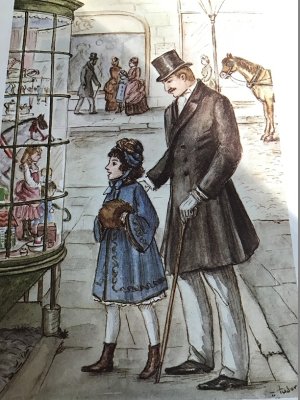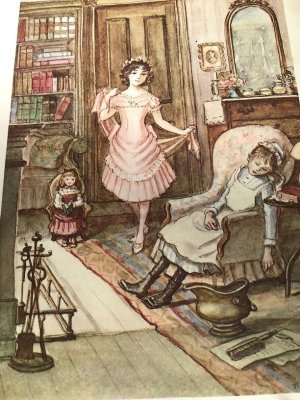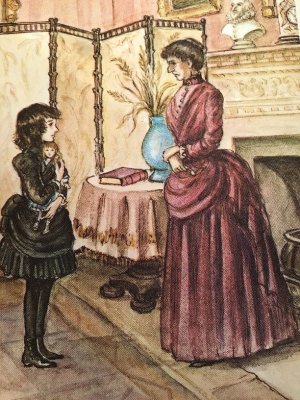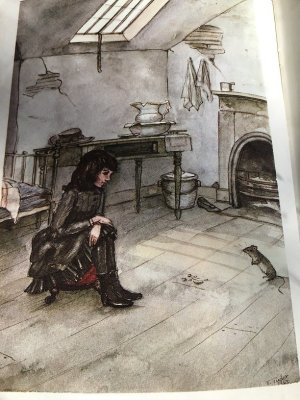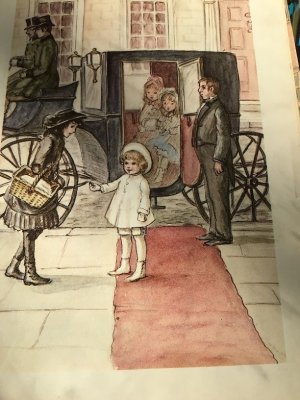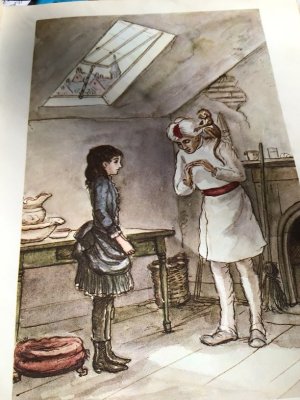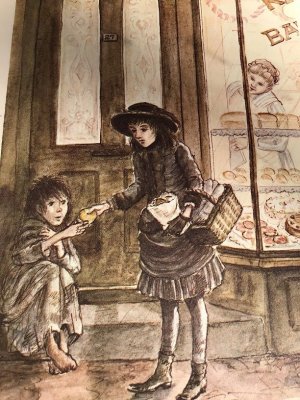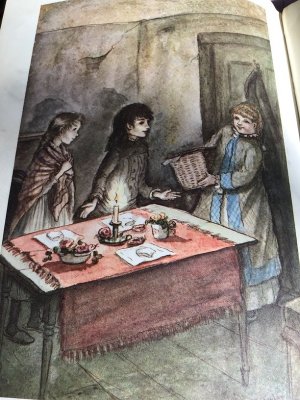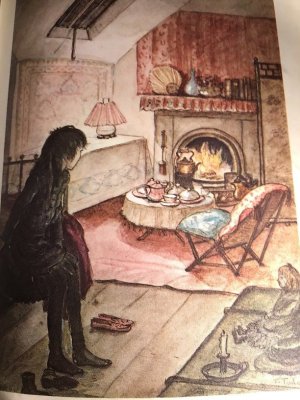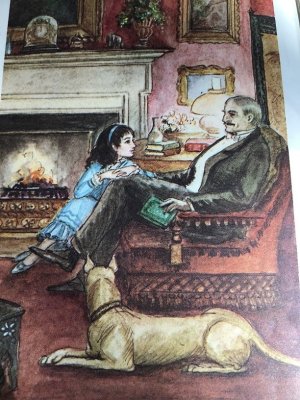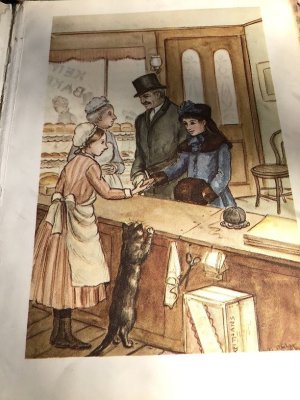A Little Princess by Frances Hodgson Burnett
My chosen book, A Little Princess, was one that I first encountered when I was in third grade (or a little older than Sara herself at the beginning of the tale). I actually have two copies now, I'm not sure how I ended up with the paperback, but I also ended up with a hard-cover that was a school library discard. As a child, I remember reading A Little Princess (Frances Hodgson Burnett) and being captivated by the 'long ago' and Cinderella-esque story with a main character who was very relatable to my child-self. Originally written as a novella in 1888, this was later expanded to be published in 1905 as the book I loved in my childhood. From contextual clues, it seems that the original date of writing (latter third of the 19th century) is also the setting of the book. There are no specific dates in the story itself, which does also seem to support the sense that this was originally written as a contemporary (from the original novella) rather than as a period piece. There are some issues with the time/passage of time in the story, but I'll hit on that after the outline of the story. I don't remember any particular memories associated with reading this book—I was a very voracious reader and had a tendency to “gobble up” books, rather like Sara herself.
The Story (for those who have not read it)
The story begins with the protagonist, Sara Crewe, being brought to London to go to school after having lived in India up to then. Sara's mother had died when Sara herself was born, so there was no one to put the brakes on her father, Ralph Crewe, spoiling her with material goods. She is enrolled in the private school run by Miss Minchin at age 7. From the outset, she is established as being both wealthy and privileged (she is at a boarding school but has a private bedroom and sitting room, a private maid, her own pony and carriage, and a very extravagant wardrobe), solemn and quiet, with a fluency in multiple languages (French is established early on, Hindi [Hindustani in the text] toward the end, in addition to English). She in initially fawned over by Miss Minchin due to her wealth. On the first day, though, Sara embarrasses Miss Minchin regarding Sara's fluency in French (and Miss Minchin's lack thereof). Sara is a brilliant student, and establishes a circle of friends—fellow student Ermengarde St John (who is a rather dull-witted, but sweet, girl Sara's age), Lottie (the youngest child in the school), and even the scullery maid (the lowest status in the house), Becky. As countering forces, there is Lavinia (the oldest student in the school, five years older than Sara) who is clearly jealous of Sara and a bit spiteful, along with Lavinia's follower, Jessie. Other students are clearly present, but never as individuals.
Sara's father gets involved in a speculative business deal involving diamond mines, and much is made of how immense the wealth will be from this. However, first there must be the dramatic downturn in Sara's life. On her 11th birthday, there is an elaborate birthday party interrupted by the news that Sara's father had died and the diamond mines were believed to be a bust, leaving her an orphaned pauper with no known relations. Between the financial losses and her long-simmering resentment of Sara for inadvertently embarrassing her on that first day in class, Miss Minchin turns Sara into a servant. During the time that follows, Sara is subjected to all sorts of abuse, including deprivation of food and being made to wear the oldest clothes she owned even though she had outgrown them. In the meantime, Mr Carrisford, the friend of her father/father's business partner, recovered from his own illness enough to look for her, although initially in all the wrong locations. In some of her darkest days, Sara finds a fourpence in the mud outside a bakery and buys four penny-buns, but the baker puts in two extra because she can see how hungry Sara is. Sara then goes outside where a beggar girl is and gives away five of those buns to the beggar girl.
By chance, Mr Carrisford had taken the house next to the school where Sara lives/works, and through Mr Carrisford's Indian servant Ram Dass, the first turning of Sara's status begins as he provides anonymously for some of her material needs. However, when the monkey belonging to Ram Dass again escapes into Sara's attic room (where she had been relegated after the death of her father), she goes to return the monkey and the truth comes out about her identity. Sara's wealth is restored, and she is taken from the school (implied that she will have private tutoring thereafter); Becky is offered a position as her personal maid (a considerable status increase for Becky), and the beggar girl was taken in by the baker and made into an apprentice, and they all live happily ever after.
Reflections
On the passage of time, there are clear references to passage of time—Sara is 7 at the outset, it is on her 11th birthday that she has the downturn in her financial position, and then around 2 years passes before her fortune is restored at the end—so an interval of 5-6 years from the beginning of the story to the end. However, at the same time, there is a static quality to the classroom—antagonist Lavinia is 12 at the start of the book, and so she should not have been still present at the end, and while Lottie seems to vanish other than in references, it doesn't seem that she ages much (she is clearly stated to be 7 at the time right after Sara's father's death, but doesn't seem characterized as different than she was at 4). I suppose the inconsistency of time is something that never occurred to me as a child, and perhaps it is something that we, as readers, have grown accustomed to demanding of our fiction in the years since 1905, but was not yet an expectation at the time of writing. This time issue could easily be ameliorated with a few minor changes to the story (for example, eliminating the age gap between Sara and Lavinia and perhaps shortening the time of Sara's 'good years' in the school), but is a bit of an inconsistency that glares to me as an adult reader returning to this story.
.
Another element which I was not particularly cognizant of as a child is the matter of social class. Sara Crewe comes from a wealthy background, living in India amongst British army officers (not enlisted) and is described as “well-bred”. While Sara, as a member of the wealthy class, is allowed to ascend back to at least her original status, and implied she is far more wealthy at the end, other characters such as Becky, Ram Dass, and Anne (the beggar girl) can only aspire to positions as a personal maid (which is a much higher status than scullery maid, but still firmly in the serving class) or other member of the working class (Ram Dass as a servant; Anne as baker's apprentice).
Princess Motif
The motif of Sara being seen as a princess occurs quite frequently though the book. Initially, these are elements based on outward realities—Sara's obvious wealth and her manners. For Sara herself, it seems to be more of an extension of what wealth means for her—that she has the opportunity, and perhaps obligation, to do good because of the status she has. When Sara's wealth seems to vanish, though, it is Becky who insists that Sara will always be a princess, no matter what happens. This does seem to help Sara through her trials as she maintains the dignity and manners that she had always displayed despite deliberate cruelty and deprivation. It is, in many ways, this manner of “how to act like a princess” which seems to be the theme of this story.
Illustrations - by Tasha Tudor
Illustrations are in both the hard cover and the paperback copies, though the paperback renders them in black and white and the hard back has them in color.











My chosen book, A Little Princess, was one that I first encountered when I was in third grade (or a little older than Sara herself at the beginning of the tale). I actually have two copies now, I'm not sure how I ended up with the paperback, but I also ended up with a hard-cover that was a school library discard. As a child, I remember reading A Little Princess (Frances Hodgson Burnett) and being captivated by the 'long ago' and Cinderella-esque story with a main character who was very relatable to my child-self. Originally written as a novella in 1888, this was later expanded to be published in 1905 as the book I loved in my childhood. From contextual clues, it seems that the original date of writing (latter third of the 19th century) is also the setting of the book. There are no specific dates in the story itself, which does also seem to support the sense that this was originally written as a contemporary (from the original novella) rather than as a period piece. There are some issues with the time/passage of time in the story, but I'll hit on that after the outline of the story. I don't remember any particular memories associated with reading this book—I was a very voracious reader and had a tendency to “gobble up” books, rather like Sara herself.
The Story (for those who have not read it)
The story begins with the protagonist, Sara Crewe, being brought to London to go to school after having lived in India up to then. Sara's mother had died when Sara herself was born, so there was no one to put the brakes on her father, Ralph Crewe, spoiling her with material goods. She is enrolled in the private school run by Miss Minchin at age 7. From the outset, she is established as being both wealthy and privileged (she is at a boarding school but has a private bedroom and sitting room, a private maid, her own pony and carriage, and a very extravagant wardrobe), solemn and quiet, with a fluency in multiple languages (French is established early on, Hindi [Hindustani in the text] toward the end, in addition to English). She in initially fawned over by Miss Minchin due to her wealth. On the first day, though, Sara embarrasses Miss Minchin regarding Sara's fluency in French (and Miss Minchin's lack thereof). Sara is a brilliant student, and establishes a circle of friends—fellow student Ermengarde St John (who is a rather dull-witted, but sweet, girl Sara's age), Lottie (the youngest child in the school), and even the scullery maid (the lowest status in the house), Becky. As countering forces, there is Lavinia (the oldest student in the school, five years older than Sara) who is clearly jealous of Sara and a bit spiteful, along with Lavinia's follower, Jessie. Other students are clearly present, but never as individuals.
Sara's father gets involved in a speculative business deal involving diamond mines, and much is made of how immense the wealth will be from this. However, first there must be the dramatic downturn in Sara's life. On her 11th birthday, there is an elaborate birthday party interrupted by the news that Sara's father had died and the diamond mines were believed to be a bust, leaving her an orphaned pauper with no known relations. Between the financial losses and her long-simmering resentment of Sara for inadvertently embarrassing her on that first day in class, Miss Minchin turns Sara into a servant. During the time that follows, Sara is subjected to all sorts of abuse, including deprivation of food and being made to wear the oldest clothes she owned even though she had outgrown them. In the meantime, Mr Carrisford, the friend of her father/father's business partner, recovered from his own illness enough to look for her, although initially in all the wrong locations. In some of her darkest days, Sara finds a fourpence in the mud outside a bakery and buys four penny-buns, but the baker puts in two extra because she can see how hungry Sara is. Sara then goes outside where a beggar girl is and gives away five of those buns to the beggar girl.
By chance, Mr Carrisford had taken the house next to the school where Sara lives/works, and through Mr Carrisford's Indian servant Ram Dass, the first turning of Sara's status begins as he provides anonymously for some of her material needs. However, when the monkey belonging to Ram Dass again escapes into Sara's attic room (where she had been relegated after the death of her father), she goes to return the monkey and the truth comes out about her identity. Sara's wealth is restored, and she is taken from the school (implied that she will have private tutoring thereafter); Becky is offered a position as her personal maid (a considerable status increase for Becky), and the beggar girl was taken in by the baker and made into an apprentice, and they all live happily ever after.
Reflections
On the passage of time, there are clear references to passage of time—Sara is 7 at the outset, it is on her 11th birthday that she has the downturn in her financial position, and then around 2 years passes before her fortune is restored at the end—so an interval of 5-6 years from the beginning of the story to the end. However, at the same time, there is a static quality to the classroom—antagonist Lavinia is 12 at the start of the book, and so she should not have been still present at the end, and while Lottie seems to vanish other than in references, it doesn't seem that she ages much (she is clearly stated to be 7 at the time right after Sara's father's death, but doesn't seem characterized as different than she was at 4). I suppose the inconsistency of time is something that never occurred to me as a child, and perhaps it is something that we, as readers, have grown accustomed to demanding of our fiction in the years since 1905, but was not yet an expectation at the time of writing. This time issue could easily be ameliorated with a few minor changes to the story (for example, eliminating the age gap between Sara and Lavinia and perhaps shortening the time of Sara's 'good years' in the school), but is a bit of an inconsistency that glares to me as an adult reader returning to this story.
.
Another element which I was not particularly cognizant of as a child is the matter of social class. Sara Crewe comes from a wealthy background, living in India amongst British army officers (not enlisted) and is described as “well-bred”. While Sara, as a member of the wealthy class, is allowed to ascend back to at least her original status, and implied she is far more wealthy at the end, other characters such as Becky, Ram Dass, and Anne (the beggar girl) can only aspire to positions as a personal maid (which is a much higher status than scullery maid, but still firmly in the serving class) or other member of the working class (Ram Dass as a servant; Anne as baker's apprentice).
Princess Motif
The motif of Sara being seen as a princess occurs quite frequently though the book. Initially, these are elements based on outward realities—Sara's obvious wealth and her manners. For Sara herself, it seems to be more of an extension of what wealth means for her—that she has the opportunity, and perhaps obligation, to do good because of the status she has. When Sara's wealth seems to vanish, though, it is Becky who insists that Sara will always be a princess, no matter what happens. This does seem to help Sara through her trials as she maintains the dignity and manners that she had always displayed despite deliberate cruelty and deprivation. It is, in many ways, this manner of “how to act like a princess” which seems to be the theme of this story.
Illustrations - by Tasha Tudor
Illustrations are in both the hard cover and the paperback copies, though the paperback renders them in black and white and the hard back has them in color.
